A Comprehensive Review of the GT-POWER for Modelling Diesel Engines
Abstract
1. Introduction
2. Overview of GT-POWER
3. GT-POWER User Interface
3.1. Navigation Through GT-POWER’s Interface
3.2. Explanation of Menus, Toolbars, and Windows
3.3. Customisation Options for User Preferences
4. Building a Diesel Engine Model in GT-POWER
- Launching GT-POWER: Upon opening the software, one begins by selecting a new project from the file menu, which sets the stage for constructing a blank workspace dedicated to the engine model. This workspace acts as the foundation from which users can build their simulation structure, thus facilitating a well-organized approach to engine modelling [28,29].
- Model tree: Once the workspace is established, users can access the model tree on the interface. This hierarchical display outlines the components within the engine model and provides a clear organization of the various elements involved. In this way, users can explore options for adding new components, thereby streamlining the process of expanding the model as required [26,28,30].
- Add engine components: The next task involves adding engine components to the model. This can be accomplished on the model tree by selecting “Add Component”. By choosing the “Engine Cylinder” option, users can accurately define the primary structure of their diesel engine. Following this, additional components such as pistons, crankshafts, valves, calorimeters, and auxiliary systems can be incorporated. These components are readily accessible from the parts library or through the component’s menu, allowing for a comprehensive assembly of the engine model [27,28,31].
- Define engine geometry: Users should begin by setting the dimensions of each component using the properties window on the interface. Key specifications, such as bore, stroke, and cylinder head configurations, must be carefully inputted to ensure accuracy. Furthermore, it is important to define the arrangement of the cylinders—whether they are inline or configured in a V-type layout—reflecting the design intentions of the engine [32,33].
- Inputting engine parameters: This task includes defining the type of fuel (such as diesel) and any relevant fuel blends by selecting appropriate options within the properties window [28]. Additionally, crucial data such as engine speed (in RPM), load conditions, and specific temperature settings must be inputted, laying the groundwork for realistic operational conditions. Users should also specify key performance characteristics, including compression ratio, boost pressure for turbocharged engines, and injection timing to optimize the model’s performance outcomes [29,34,35].
- Combustion models setup: GT-POWER offers various options, including single-zone and multi-zone combustion models, allowing users to select the model that best fits their analysis needs [27,28,33]. Adjustments to settings related to ignition timing, air-fuel ratio, and combustion efficiency can then be made to fine-tune the model’s predictive capabilities.
5. Simulation Setup and Execution
5.1. Setting Simulation Parameters and Conditions
5.2. Running Simulations and Interpreting Results
6. Challenges and Troubleshooting Methods
- Model complexity: One notable challenge is model complexity; designing a comprehensive and detailed model that accurately represents all engine components and operational conditions can be both overwhelming and time-consuming [44,45]. The complex nature of engine systems demands an iterative approach, in which users begin with a simplified representation that captures key components and functionalities. Once a basic model is established, additional details and complexities can be incorporated gradually, allowing for more manageable development and refinement [46].
- Data input errors: Another common issue is the occurrence of data input errors which can significantly undermine the validity of simulation results. When incorrect or incomplete data is entered into the model, the subsequent outputs may reflect inaccuracies that mislead analysis and decision-making. To mitigate this risk, thorough validation of all input parameters is essential [47]. Users should establish a concise review process to ensure that the data entered is both accurate and complete, thereby preventing potential data-related discrepancies that could compromise simulation integrity.
- Simulation convergence issues: Users may encounter simulation convergence issues which manifest as difficulties in achieving stable solutions during runs. These issues may stem from overly complex models or inappropriate parameter settings that hinder the user’s ability to find a solution. In such instances, users should consider modifying the solver settings—potentially by adjusting the time step size or modifying iteration limits—to enhance stability and promote convergence within the simulations [46,48]. Ensuring that the simulation settings are appropriately aligned with the model’s complexity is a critical aspect of effective troubleshooting in GT-POWER.
- Combustion models: The selection and configuration of combustion models present another layer of complexity for users, particularly for those who may lack extensive knowledge of combustion processes. Understanding the distinction of the various combustion models available in GT-POWER is crucial for achieving accurate representations of combustion phenomena. To assist users in navigating this challenge, GT-POWER provides built-in help resources and user manuals, which are invaluable for clarifying specific error messages and offering recommended solutions [34,49]. By employing these resources, users can enhance their understanding and better configure the appropriate combustion model suited to their simulation objectives. Overall, addressing these challenges with a systematic and informed approach can significantly enhance the effectiveness of simulations in GT-POWER and contribute to more reliable outcomes in IC engine modelling.
7. Comparisons with Alternative Modelling Tools
8. Practical Application of GT-POWER for Modelling Diesel Engines
8.1. Optimisation of Engine Performance
8.2. Designing Engine Components
8.3. Incorporation of Biodiesel Blends
8.4. Integration with Dynamic Machine Learning
8.4.1. MATLAB/Simulink
8.4.2. Neutral Network
8.4.3. Python
8.5. Novel Insights Gained
8.5.1. Emerging Trends
8.5.2. Underexplored Areas
9. Conclusions
Author Contributions
Funding
Data Availability Statement
Conflicts of Interest
Abbreviations
| GTs | Gamma technologies |
| IC | Internal combustion |
| 1D | One dimensional |
| GUI | Graphical user interface |
| RPMs | Revolutions per minute |
| CFD | Computational fluid dynamics |
| 3D | Three dimensional |
| BSFC | Brake thermal fuel consumption |
| BMEP | Brake mean effective pressure |
| DI | Direct injection |
| NOx | Nitrogen oxides |
| PPMs | Parts per million |
| HC | Hydrocarbon |
| CO | Carbon monoxide |
| CI | Compression ignition |
| CNG | Compressed natural gas |
| AC | Alternative current |
| MCP | Maximum combustion pressure |
| BED | Biodiesel–ethanol–diesel |
| PID | Proportional-integral-derivative |
| DF | Dual fuel |
| AI | Artificial intelligence |
| ML | Machine learning |
| ANN | Artificial neural network |
| RMSE | Root mean square error |
| BPANN | Back-propagation artificial neural network |
| API | Application programming interface |
| GT-ISE | Gamma technologies integrated simulation environment |
| CSVs | Comma separated values |
| TXT | Text |
References
- Soudagar, M.E.M.; Shelare, S.; Marghade, D.; Belkhode, P.; Nur-E-Alam, M.; Kiong, T.S.; Ramesh, S.; Rajabi, A.; Venu, H.; Khan, Y.; et al. Optimizing IC Engine Efficiency: A Comprehensive Review on Biodiesel, Nanofluid, and the Role of Artificial Intelligence and Machine Learning. Energy Convers. Manag. 2024, 307, 118337. [Google Scholar] [CrossRef]
- Ogunkunle, O.; Ahmed, N.A. A Review of the Global Current Scenario of Biodiesel Adoption and Combustion in Vehicular Diesel Engines. Energy Rep. 2019, 5, 1560–1579. [Google Scholar] [CrossRef]
- Dong, N.P.; Tuan, N.T.; Prochazka, R. Performance Parameters Reevaluate and Predict the Fuel Consumption of Cummin Engine Running on CNG-Diesel Duel Fuel by GT-Power Software. In Proceedings of the 2021 International Conference on System Science and Engineering (ICSSE), Ho Chi Minh City, Vietnam, 26–28 August 2021; pp. 283–288. [Google Scholar] [CrossRef]
- Wei, S.; Zhang, Z.; Li, X.; Wu, C.; Yang, F. Simulation Analysis of Fuel Economy of the GDI Engine with a Miller Cycle and EGR Based on GT-Power. Processes 2022, 10, 319. [Google Scholar] [CrossRef]
- Bai, Y.; Wang, H.; Yang, C.; Wang, Y. Fault Simulation and Analysis of Marine Low-Speed Diesel Engine Based on GT-Power. In Proceedings of the International Conference on Marine Equipment & Technology and Sustainable Development METSD 2023, Beijing, China, 1 April 2023; Lecture Notes in Civil Engineering. Yang, D., Ed.; Springer: Singapore, 2023; Volume 375, pp. 978–987. [Google Scholar] [CrossRef]
- Frost, J.; Tall, A.; Sheriff, A.M.; Schönborn, A.; Hellier, P. An experimental and modelling study of dual fuel aqueous ammonia and diesel combustion in a single cylinder compression ignition engine. Int. J. Hydrogen Energy 2021, 46, 35495–35510. [Google Scholar] [CrossRef]
- Robertson, D.M.; Conway, G.; Chadwell, C.; McDonald, J.; Barba, D.; Stuhldreher, M.; Birkett, A. Predictive GT-Power Simulation for VNT Matching on a 1.6 L Turbocharged GDI Engine; SAE Technical Paper 2018-01-0161; SAE International: Warrendale, PA, USA, 2018. [Google Scholar] [CrossRef]
- Trajkovic, S.; Tunestål, P.; Johansson, B. Simulation of a Pneumatic Hybrid Powertrain with VVT in GT-Power and Comparison with Experimental Data; SAE Technical Paper 2009-01-1323; SAE International: Warrendale, PA, USA, 2019. [Google Scholar] [CrossRef]
- Barua, U.; Kaur, G.; Miah, M.H. The Comparison of Biofuel from Waste Oil, Methanol, and Diesel Using GT-POWER Based on Economic and Environmental Impact Analysis. In Proceedings of the 2022 International Conference on Emerging Trends in Engineering and Medical Sciences (ICETEMS), Nagpur, India, 18–19 November 2022; pp. 102–107. [Google Scholar] [CrossRef]
- Ismail, M.Y.; Alimin, A.J.; Osman, S.A. Mono-Gas Fuelled Engine Performance and Emissions Simulation Using GT-Power. Appl. Mech. Mater. 2023, 465–466, 125–129. [Google Scholar] [CrossRef]
- Fan, S. Simulation of Engine and Control System Based on GT-POWER and Simulink. Jisuanji Fangzhen 2018, 20, 4379–4381. [Google Scholar]
- Deere, J. Transient engine modeling at John Deere using GT-POWER. In Proceedings of the GT-SUITE North American Conference, Plymouth, MI, USA, 4–5 November 2019. [Google Scholar]
- Park, Y.; Park, T.; Lee, C.-E. Development of 1D Simulation Model for a New Type Rotary Engine Using GT-POWER. Trans. Korean Soc. Automot. Eng. 2021, 29, 11–20. [Google Scholar] [CrossRef]
- Hatlevold, E.S. Assessment of Engine Performance and Exhaust Emission at Changing Operating Conditions and Under Fault Conditions. Master’s Thesis, Norwegian University of Science and Technology, Trondheim, Norway, 2019. Available online: http://hdl.handle.net/11250/237746 (accessed on 3 February 2025).
- Klingbeil, A.; Lavertu, T. Method for Estimating Compression Ratio and Heat Transfer Multiplier Using GT-Power and Experimental Pressure Traces. In Proceedings of the ASME 2020 Internal Combustion Engine Division Fall Technical Conference, Online, 4–6 November 2020; V001T01A007. [Google Scholar] [CrossRef]
- Ahlskog, A. Operating a Single-Cylinder Engine with a Multi-Cylinder Engine 1D-Model in the Loop with Real-Time Combustion Feedback. Master’s Thesis, Novia University of Applied Sciences, Vaasa, Finland, 2023. Available online: http://www.theseus.fi/handle/10024/804188 (accessed on 3 February 2025).
- Söderäng, E.; Hautala, S.; Mikulski, M.; Storm, X.; Niemi, S. Development of a Digital Twin for Real-Time Simulation of a Combustion Engine-Based Power Plant with Battery Storage and Grid Coupling. Energy Convers. Manag. 2022, 266, 115793. [Google Scholar] [CrossRef]
- Hou, X.J.; Chen, S.; Liu, Z. EGR System Performance Optimization of Diesel Engine Based on GT-Power and Fluent Co-Simulation. Adv. Mat. Res. 2019, 860–863, 1703–1709. [Google Scholar] [CrossRef]
- McCrady, J.; Hansen, A.; Lee, C.-F. Modeling Biodiesel Combustion Using GT-Power. In Proceedings of the 2019 ASABE Annual International Meeting, Minneapolis, MN, USA, 7–10 July 2019. [Google Scholar]
- Kumar, V.V.M. Predictive Diesel Combustion Using DI-Pulse in GT-POWER. Master’s Thesis, Chalmers University of Technology, Gothenberg, Sweden, 2015. Available online: https://odr.chalmers.se/handle/20.500.12380/225450 (accessed on 3 February 2025).
- Fasulo, G.; Bozza, F.; Malfi, E.; Teodosio, L. Development of a 0D Multi-Zone Model for Fast and Accurate Prediction of Homogeneous Charge Compression Ignition (HCCI) Engine. E3S Web Conf. 2021, 312, 07006. [Google Scholar] [CrossRef]
- Smulter, B. Building a GT-Power-in-the-Loop System Comprising a Fast-Running Model as an Extended Digital Twin for a Single-Cylinder Research Engine. Master’s Thesis, University of Vaasa, Vaasa, Finland, 2024. Available online: https://osuva.uwasa.fi/handle/10024/17427 (accessed on 3 February 2025).
- Fogliarino, M. Crankcase Pressure Control in an Internal Combustion Engine: GT-Power Simulation. Master’s Thesis, University of Windsor, Windsor, UK, 2015. Available online: https://scholar.uwindsor.ca/etd/5218 (accessed on 3 February 2025).
- Magalhães Avelar, F.; Rodrigues Filho, F.; da Costa, R.; Duarte, V.; Magalhães Avelar, T.; de Sousa Gama, H.F.; de Sousa, J.L.F. Numerical Model of SI Engine Using GT-POWER Code; SAE Technical Paper 2019-36-0170; SAE International: Warrendale, PA, USA, 2020. [Google Scholar] [CrossRef]
- Gamma Technologies, GT-SUITE Flow Manual. 2023. Available online: https://www.gtisoft.com/gamma_news/gt-suite-v2023-released/ (accessed on 3 February 2025).
- Brasacchio, M. Modelling of a Heavy Duty Diesel Engine and Its Conversion to Real-Time Model. Ph.D. Thesis, Politecnico di Torino, Torino, Italy, 2020. Available online: https://webthesis.biblio.polito.it/14730/1/tesi.pdf (accessed on 3 February 2025).
- Gamma Technologies, GT-SUITE Engine Performance Tutorials. 2024. Available online: https://www.gtisoft.com/training-catalogs/ (accessed on 3 February 2025).
- Salih, S.; DelVescovo, D. Design and Validation of a GT Power Model of the CFR Engine Towards the Development of a Boosted Octane Number (No. 2018-01-0214); SAE Technical Paper 2018-01-0214; SAE International: Warrendale, PA, USA, 2018. [Google Scholar] [CrossRef]
- Gonzalez, J.P.; Waqas, M.U.; Kolodziej, C.P.; DelVescovo, D.; Ross, T.G. Improvements to a CFR Engine Three Pressure Analysis GT-Power Model for HCCI and SI Conditions (No. 2019-32-0608); SAE Technical Paper 2019-32-0608; SAE International: Warrendale, PA, USA, 2020. [Google Scholar] [CrossRef]
- Subramaniam, K.; Wan Salim, W.S.-I. Simulation of the Performance of an Electrically Turbocharged Engine Over an Urban Driving Cycle. Int. J. Automot. Mech. Eng. 2024, 21, 11139–11154. [Google Scholar] [CrossRef]
- Feng, R.; Yu, J.; Shu, X.; Deng, B.; Hua, Z. Can the World Harmonized Steady Cycle (WHSC) Accurately Reflect Real-World Driving Conditions for Heavy-Duty Diesel Engine Emission Valuations? A Comprehensive Experimental Study. Therm. Sci. Eng. Prog. 2025, 59, 103321. [Google Scholar] [CrossRef]
- Chang, C.S.; Zhang, Y.; Bray, K.N.C.; Rogg, B. Modelling and Simulation of Autoignition Under Simulated Diesel-Engine Conditions. Combust. Sci. Technol. 2016, 113, 205–219. [Google Scholar] [CrossRef]
- Ahammed, S. Hydrogen-Argon Power Cycle (HAPC) on a Wartsila Medium-Speed Engine: An Investigation Using 1D-Simulation. Master’s Thesis, University of Vaasa, Vaasa, Finland, 2025. Available online: https://osuva.uwasa.fi/handle/10024/18624 (accessed on 3 February 2025).
- Deng, B.; Cai, W.; Zhang, W.; Bian, L.; Che, X.; Xiang, Y.; Wu, D. A Comprehensive Investigation of EGR (Exhaust Gas Recirculation) Effects on Energy Distribution and Emissions of a Turbo-Charging Diesel Engine Under World Harmonized Transient Cycle. Energy 2025, 316, 134506. [Google Scholar] [CrossRef]
- Lakshminarayanan, P.A.; Aghav, Y.V. Modelling Diesel Combustion; Springer Science & Business Media: Cham, Switzerland, 2010. [Google Scholar]
- Mills, Z.G.; Finney, C.E.A.; Haynes, J.A.; Trofimov, A.A.; Wang, H.; Pierce, D.T. Impact of Materials Properties on Higher-Temperature Engine Operation. SAE Int. J. Adv. Curr. Pract. Mobil. 2021, 4, 448–461. [Google Scholar] [CrossRef]
- McBreen, J.M. Matching 1-Dimensional Engine Flow Solution with Digital Twin Requirements for System-Level Simulations: A Model-In-The-Loop Study of an Engine-Based Stationary Power Plant. Master’s Thesis, University of Vaasa, Vaasa, Finland, 2024. Available online: https://osuva.uwasa.fi/handle/10024/17809 (accessed on 3 February 2025).
- Zhang, Y.; Rutland, C.J. A Mixing Controlled Direct Chemistry (MCDC) Model for Diesel Engine Combustion Modelling Using Large Eddy Simulation. Combust. Theor. Model. 2012, 16, 571–588. [Google Scholar] [CrossRef]
- Ismail, M.I. One-Dimensional Modelling of Pulse Separation Strategy, Waste-Gated Turbines and Electric Turbocharger Systems for Downsized Turbocharged Gasoline Engines. Ph.D. Thesis, Imperial College, London, UK, 2017. [Google Scholar] [CrossRef]
- Ayele, Y.M. Experimental Analysis and Model Development of Dual Mode, Turbulent Jet Ignition (DM-TJI) Engine Operating with Gasoline and Alternative Fuels. Ph.D. Thesis, Michigan State University, East Lansing, MI, USA, 2022. [Google Scholar] [CrossRef]
- Wang, Z.; Scarcelli, R.; Som, S.; McConnell, S.; Salman, N.; Zhu, Y.; Hardman, K.; Freeman, K.; Reese, R.; Senecal, P.K.; et al. Multi-Dimensional Modeling and Validation of Combustion in a High-Efficiency Dual-Fuel Light-Duty Engine; SAE Technical Paper 2013-01-1091; SAE International: Warrendale, PA, USA, 2013. [Google Scholar] [CrossRef]
- Li, X.; Zhong, L.; Zhou, L.; Jia, M.; Wei, H. Numerical Study of Turbulent Jet Ignition Process at Different Injection Strategies in a Single-Cylinder Engine with Active Pre-Chamber. Combust. Sci. Technol. 2022, 196, 455–479. [Google Scholar] [CrossRef]
- Bureshaid, K.; Feng, D.; Bunce, M.; Zhao, H. Experimental Studies of Gasoline Auxiliary Fueled Turbulent Jet Igniter at Different Speeds in Single Cylinder Engine; SAE Technical Paper 2019-24-0105; SAE International: Warrendale, PA, USA, 2019. [Google Scholar] [CrossRef]
- Pirker, G.; Wimmer, A. Sustainable Power Generation with Large Gas Engines. Energy Convers. Manag. 2017, 149, 1048–1065. [Google Scholar] [CrossRef]
- Krzywanski, J.; Sosnowski, M.; Grabowska, K.; Zylka, A.; Lasek, L.; Kijo-Kleczkowska, A. Advanced Computational Methods for Modeling, Prediction and Optimization—A Review. Materials 2024, 17, 3521. [Google Scholar] [CrossRef]
- Gogoi, T.K.; Baruah, D.C. A cycle simulation model for predicting the performance of a diesel engine fuelled by diesel and biodiesel blends. Energy 2019, 35, 1317–1323. [Google Scholar] [CrossRef]
- Wang, Y.; Conway, G.; McDonald, J.; Birckett, A. Predictive GT-Power Simulation for VNT Matching to EIVC Strategy on a 1.6 L Turbocharged GDI Engine; SAE Technical Paper 2019-01-0192; SAE International: Warrendale, PA, USA, 2019. [Google Scholar] [CrossRef]
- Galindo, J.; Climent, H.; de la Morena, J.; González-Domínguez, D.; Guilain, S.; Besançon, T. Experimental and Modeling Analysis on the Optimization of Combined VVT and EGR Strategies in Turbocharged Direct-Injection Gasoline Engines with VNT. Proc. Inst. Mech. Eng. Part D J. Automob. Eng. 2021, 235, 2843–2856. [Google Scholar] [CrossRef]
- He, G.; Xie, H.; He, S. Overall Efficiency Optimization of Controllable Mechanical Turbo-Compounding System for Heavy Duty Diesel Engines. Sci. China Technol. Sci. 2016, 60, 36–50. [Google Scholar] [CrossRef]
- Marques, C.; Caprace, J.-D.; Belchior, C.; Martini, A. An Approach for Predicting the Specific Fuel Consumption of Dual-Fuel Two-Stroke Marine Engines. J. Mar. Sci. Eng. 2019, 7, 20. [Google Scholar] [CrossRef]
- Ismail, F.B.; Al-Bazi, A.; Aboubakr, I.G. Numerical Investigations on the Performance and Emissions of a Turbocharged Engine Using an Ethanol-Gasoline Blend. Case Stud. Therm. Eng. 2022, 39, 102366. [Google Scholar] [CrossRef]
- Shivapuji, A.M.; Dasappa, S. Quasi Dimensional Numerical Investigation of Syngas Fuelled Engine Operation: MBT Operation and Parametric Sensitivity Analysis. Appl. Therm. Eng. 2017, 124, 911–928. [Google Scholar] [CrossRef]
- Pathak, B.; Shekh, A.; Patel, N.; Patel, V. Review Analysis on CFD Techniques and Numerical Methods for IC Engines Fueled with Diesel and Biofuels. J. Adv. Res. Fluid Mech. Therm. Sci. 2023, 110, 40–62. [Google Scholar] [CrossRef]
- Woś, P.; Jakubowski, M. Numerical and Experimental Studies on Combustion Engines and Vehicles; IntechOpen: Rijeka, Croatia, 2020. [Google Scholar] [CrossRef]
- Fonseca, L.G. Methodology for Analysis of Boundary Conditions in order to Increase Accuracy Associated to Internal Combustion Engine CFD 3D Models. Ph.D. Thesis, Universidade Federal de Minas Gerais, Minas Gerais, Brazil, 2019. Available online: http://hdl.handle.net/1843/32523 (accessed on 4 February 2025).
- Blinov, A.S.; Malastowski, N.S.; Myagkov, L.L. Numerical Simulation of NOx Reduction in a SCR System. IOP Conf. Ser. Mater. Sci. Eng. 2021, 1111, 012009. [Google Scholar] [CrossRef]
- Nagarajan, P.C.; Ström, H.; Sjöblom, J. Transient Flow Uniformity Evolution in Realistic Exhaust Gas Aftertreatment Systems Using 3D-CFD. Emiss. Control Sci. Technol. 2022, 8, 154–170. [Google Scholar] [CrossRef]
- Kakoee, A.; Vasudev, A.; Smulter, B.; Hyvonen, J.; Mikulski, M. A Predictive 1D Modeling Framework for Reactivity-Controlled Compression Ignition Engines, via a Chemistry-Based, Multizone Combustion Object; SAE Technical Paper 2023-24-0001; SAE International: Warrendale, PA, USA, 2023. [Google Scholar] [CrossRef]
- Kulkarni, D.; Patil, A.; Wagh, J.; Chougule, S.D. Modelling of Internal Combustion Engine using GT Power. Int. J. Eng. Res. Technol. 2019, 8, 92–94. [Google Scholar]
- Johansson, E.; Wagnborg, S. Analysis of Engine Cold Start Simulation in GT-POWER. Master’s Thesis, Chalmers University of Technology, Gothenberg, Sweden, 2014. Available online: https://publications.lib.chalmers.se/records/fulltext/201466/201466.pdf (accessed on 16 February 2025).
- Semin; Bakar, R.A.; Ismail, A.R. Computational Visualization and Simulation of Diesel Engines Valve Lift Performance Using CFD. Am. J. Appl. Sci. 2008, 5, 532–539. [Google Scholar] [CrossRef]
- Verma, A.; Bhosale, P. Model-Based Study on Effects of Valve Lifts and Events on the Performance of an Engine. Int. Res. J. Eng. Technol. 2020, 7, 580–586. [Google Scholar]
- Done, L.; Lahane, S.; Nandgaonkar, M.R. Modeling of Single Cylinder Compression Ignition Engine by Using GT-POWER Software and Performance Analysis. In Proceedings of the 2nd Indian International Conference on Industrial Engineering and Operations Management, Warangal, India, 16–18 August 2022. [Google Scholar]
- Mohiuddin, A.K.M.; Rahman, A.; Dzaidin, M. Optimal Design of Automobile Exhaust System Using GT- POWER. Int. J. Mech. Mater. Eng. 2017, 2, 40–47. [Google Scholar]
- Wang, Z.; Pan, J.; Su, W. Design of Racing Car Muffler in FSAE Based on GT-POWER. J. Phys. Conf. Ser. 2021, 1972, 012033. [Google Scholar] [CrossRef]
- Chen, J.; Zhang, C.; Chen, W.; Zhang, Z. Design and Optimization of the Exhaust System for an Aviation Piston Engine. J. Phys. Conf. Ser. 2024, 2879, 012005. [Google Scholar] [CrossRef]
- Mohan, B.; Raju, S.; Srinivasnaik, M. Experimental Investigation on Performance Characteristics of Diesel Engine Using Various Blended Biodiesels. Indian J. Sci. Technol. 2024, 17, 3865–3870. [Google Scholar] [CrossRef]
- Onorati, A.; Montenegro, G. 1D and Multi-D Modeling Techniques for IC Engine Simulation; SAE International: Warrendale, PA, USA, 2019. [Google Scholar]
- Jiang, F.; Cao, W.; Tan, X.; Hu, J.; Zhou, J.; Tan, Z. Optimization Analysis of Locomotive Diesel Engine Intake System Based on Matlab-Simulink and GT-POWER. Processes 2022, 10, 157. [Google Scholar] [CrossRef]
- Semin; Ismail, A.R.; Bakar, R.A. Comparative Performance of Direct Injection Diesel Engines Fueled Using Compressed Natural Gas and Diesel Fuel Based on GT-POWER Simulation. Am. J. Appl. Sci. 2018, 5, 540–547. [Google Scholar] [CrossRef]
- Shah, A.N.; Shah, F.H.; Shahid, E.M.; Gardezi, S.A.R. Prediction of an Optimum Biodiesel-Diesel Blended Fuel for Compression Ignition Engine Using GT-POWER. Pak. J. Eng. Appl. Sci. 2016, 14, 102–114. [Google Scholar]
- Yahuza, I.; Dandakouta, H.; Ibrahim, M.H.; Dasin, D.Y. Modelling and Simulation of Some Combustion Parameters Intport-1 and Intvalve-1 Using Gt-POWER Engine Simulation Software with Biodiesel-Ethanol-Diesel Blends as Fuel. Int. J. Trend Sci. Res. Dev. 2018, 3, 1206–1214. [Google Scholar] [CrossRef]
- Peters, J.F.; Iribarren, D.; Dufour, J. Simulation and Life Cycle Assessment of Biofuel Production via Fast Pyrolysis and Hydroupgrading. Fuel 2015, 139, 441–456. [Google Scholar] [CrossRef]
- Yuan, H.; Goyal, H.; Islam, R.; Giles, K.; Howson, S.; Lewis, A.; Parsons, D.; Esposito, S.; Akehurst, S.; Jones, P.; et al. Thermodynamics-Based Data-Driven Combustion Modelling for Modern Spark-Ignition Engines. Energy 2024, 313, 134074. [Google Scholar] [CrossRef]
- Jiang, F.; Li, M.; Wen, J.; Tan, Z.; Zhou, W. Optimization Analysis of Engine Intake System Based on Coupling Matlab-Simulink with GT-Power. Math. Probl. Eng. 2021, 2021, 6673612. [Google Scholar] [CrossRef]
- Zhang, Q.; Jiang, Y. Modeling and Control of Methanol Engine Speed with GT-Power and Simulink. IOP Conf. Ser. Mater. Sci. Eng. 2019, 677, 032003. [Google Scholar] [CrossRef]
- Meng, D.; Gan, H.; Wang, H. Modeling and Optimization of the Flue Gas Heat Recovery of a Marine Dual-Fuel Engine Based on RSM and GA. Processes 2022, 10, 674. [Google Scholar] [CrossRef]
- Ricci, F.; Avana, M.; Mariani, F. Artificial Neural Networks as a Tool for High-Accuracy Prediction of In-Cylinder Pressure and Equivalent Flame Radius in Hydrogen-Fueled Internal Combustion Engines. Energies 2025, 18, 299. [Google Scholar] [CrossRef]
- Yap, W.K.; Karri, V. ANN Virtual Sensors for Emissions Prediction and Control. Appl. Energy 2011, 88, 4505–4516. [Google Scholar] [CrossRef]
- Jaliliantabar, F.; Ghobadian, B.; Najafi, G.; Yusaf, T. Artificial Neural Network Modeling and Sensitivity Analysis of Performance and Emissions in a Compression Ignition Engine Using Biodiesel Fuel. Energies 2018, 11, 2410. [Google Scholar] [CrossRef]
- Parlak, A.; Islamoglu, Y.; Yasar, H.; Egrisogut, A. Application of Artificial Neural Network to Predict Specific Fuel Consumption and Exhaust Temperature for a Diesel Engine. Appl. Therm. Eng. 2019, 26, 824–828. [Google Scholar] [CrossRef]
- Cho, J.; Song, S. Prediction of Hydrogen-Added Combustion Process in T-GDI engine Using Artificial Neural Network. Appl. Therm. Eng. 2020, 181, 115974. [Google Scholar] [CrossRef]
- Ghobadian, B.; Rahimi, H.; Nikbakht, A.M.; Najafi, G.; Yusaf, T.F. Diesel Engine Performance and Exhaust Emission Analysis Using Waste Cooking Biodiesel Fuel with an Artificial Neural Network. Renew. Energy 2009, 34, 976–982. [Google Scholar] [CrossRef]
- Najafi, G.; Ghobadian, B.; Tavakoli, T.; Buttsworth, D.R.; Yusaf, T.F.; Faizollahnejad, M. Performance and Exhaust Emissions of a Gasoline Engine with Ethanol Blended Gasoline Fuels Using Artificial Neural Network. Appl. Energy 2009, 86, 630–639. [Google Scholar]
- Warey, A.; Gao, J.; Grover, R. Prediction of Engine-Out Emissions Using Deep Convolutional Neural Networks. SAE Int. J. Adv. Curr. Pract. Pract. 2021, 3, 2863–2871. [Google Scholar] [CrossRef]
- Liao, J.; Hu, J.; Yan, F.; Chen, P.; Zhu, L.; Zhou, Q.; Xu, H.; Li, J. A Comparative Investigation of Advanced Machine Learning Methods for Predicting Transient Emission Characteristic of Diesel Engine. Fuel 2023, 350, 128767. [Google Scholar] [CrossRef]
- Khurana, S.; Saxena, S.; Jain, S.; Dixit, A. Predictive Modeling of Engine Emissions Using Machine Learning: A Review. Mater. Today Proc. 2020, 38, 280–284. [Google Scholar] [CrossRef]
- Oğuz, H.; Sarıtas, I.; Baydan, H.E. Prediction of Diesel Engine Performance Using Biofuels with Artificial Neural Network. Expert Syst. Appl. 2010, 37, 6579–6586. [Google Scholar] [CrossRef]
- Pukai, W. Research on Development of Simulation Interface of Engine Speed Characteristics Based on GT-POWER. Sci. Discov. 2018, 6, 332. [Google Scholar] [CrossRef]
- Bos, M. Validation GT-Power Model Cyclops Heavy Duty Diesel; Technical University of Eindhoven: Eindhoven, The Netherlands, 2020. [Google Scholar]
- López, E.J.; Nigro, N.M. Validation of a 0D/1D Computational Code for the Design of Several Kinds of Internal Combustion Engines. Lat. Am. Appl. Res. 2010, 40, 175–184. [Google Scholar]
- Howroyd, S.; Thring, R. An Electric Vehicle Model and Validation Using a Nissan Leaf: A Python-Based Object-Oriented Programming Approach. Adv. Mech. Eng. 2018, 10, 168781401878209. [Google Scholar] [CrossRef]
- Krebs, S.; Biet, C. Validation of a Predictive Model of a Premixed, Lean Hydrogen Combustion for Internal Combustion Engines. Int. J. Hydrogen Energy 2024, 86, 1171–1178. [Google Scholar] [CrossRef]
- Williams, Z.; Moiz, A.; Cung, K.; Smith, M.; Briggs, T.; Bitsis, C.; Miwa, J. Generation of Rate-of-Injection (ROI) Profile for Computational Fluid Dynamics (CFD) Model of Internal Combustion Engine (ICE) Using Machine Learning. Energy AI 2022, 8, 100148. [Google Scholar] [CrossRef]
- Norouzi, A.; Heidarifar, H.; Shahbakhti, M.; Koch, C.R.; Borhan, H. Model Predictive Control of Internal Combustion Engines: A Review and Future Directions. Energies 2021, 14, 6251. [Google Scholar] [CrossRef]
- Kharroubi, F.; Fertat, M.; El Hassani, S.; Ouahmane, H. Design, Simulation and Control of a Marine Ship Model’s Diesel Engine Using Python and Matlab/Simulink. Manuf. Technol. 2021, 21, 483–491. [Google Scholar] [CrossRef]
- Silva Assis, M.; de Castro, D.; Araújo Moreira, T.; Rodrigues Filho, F.; Malaquias, A.; Coelho Baeta, J. Numerical Study of Compression Ratio Influence on Specific Fuel Consumption of an Ethanol Fueled Engine Using GT POWER Code; SAE Technical Paper 2022-36-0075; SAE International: Warrendale, PA, USA, 2023. [Google Scholar] [CrossRef]
- Boruah, D.; Thakur, P.K.; Baruah, D. Artificial Neural Network-based Modelling of Internal Combustion Engine Performance. Int. J. Eng. Res. Technol. 2016, 5, 568–576. [Google Scholar] [CrossRef]
- Ortiz-Soto, E.; Assanis, D.; Babajimopoulos, A. A Comprehensive Engine to Drive-Cycle Modelling Framework for the Fuel Economy Assessment of Advanced Engine and Combustion Technologies. Int. J. Engine Res. 2011, 13, 287–304. [Google Scholar] [CrossRef]
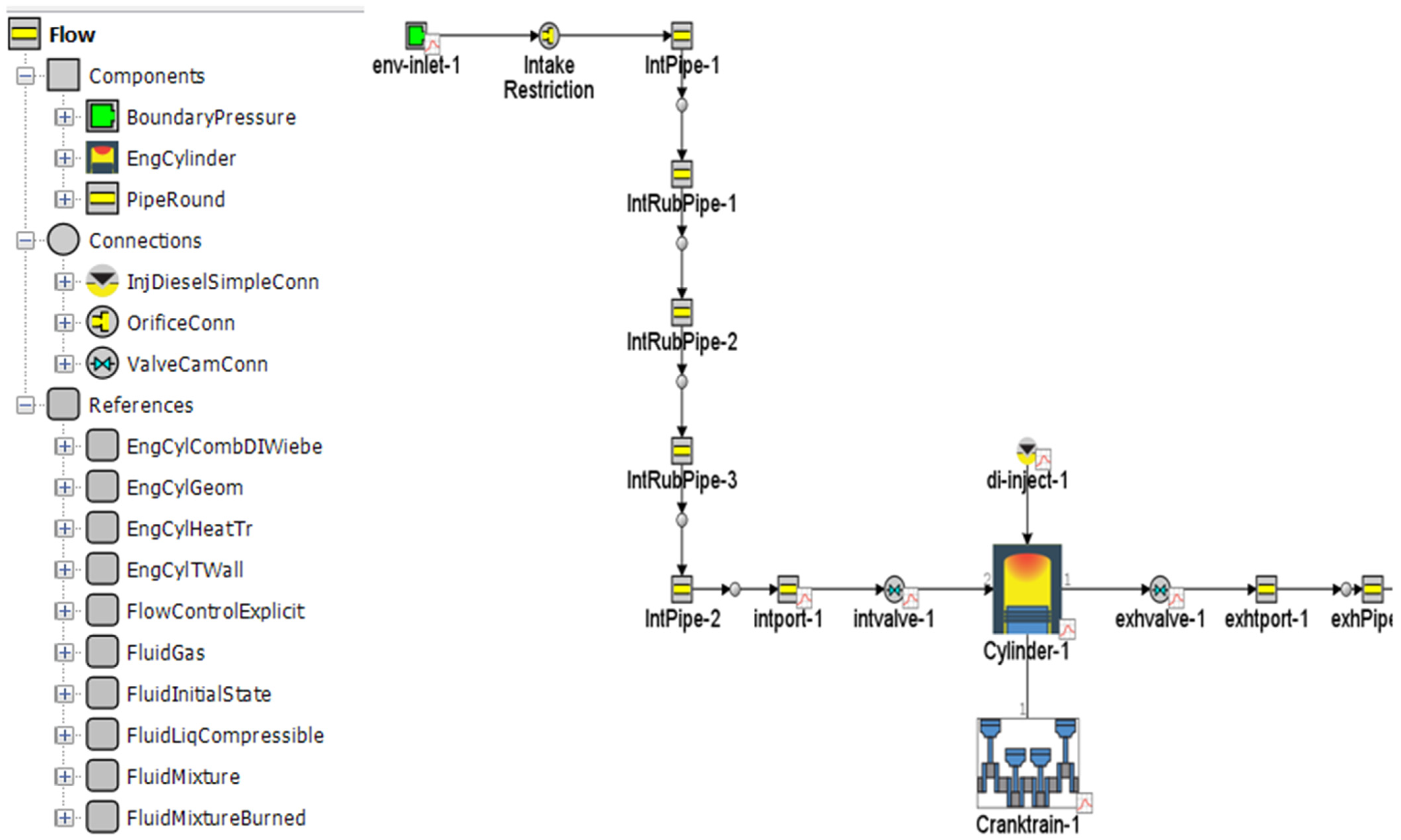


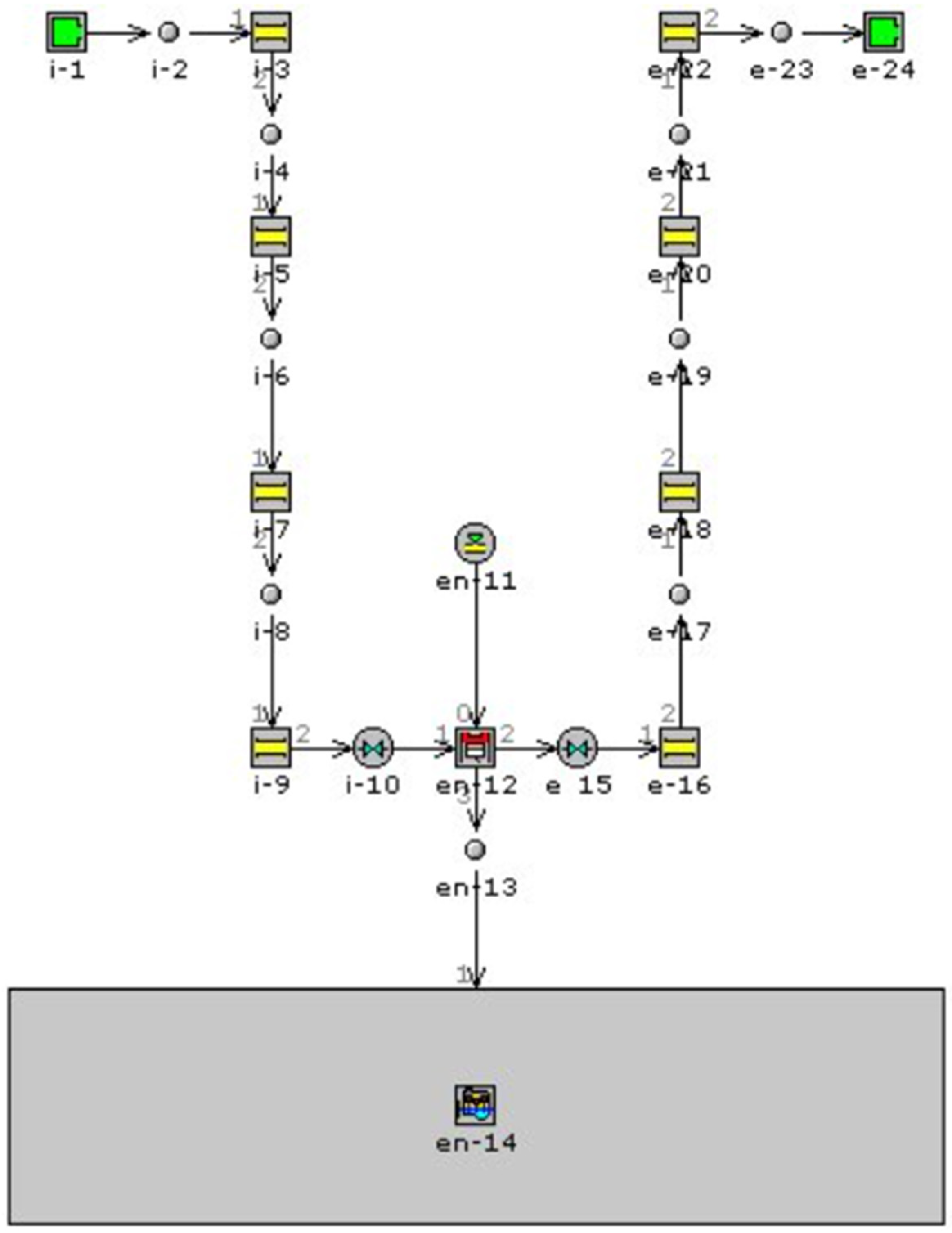
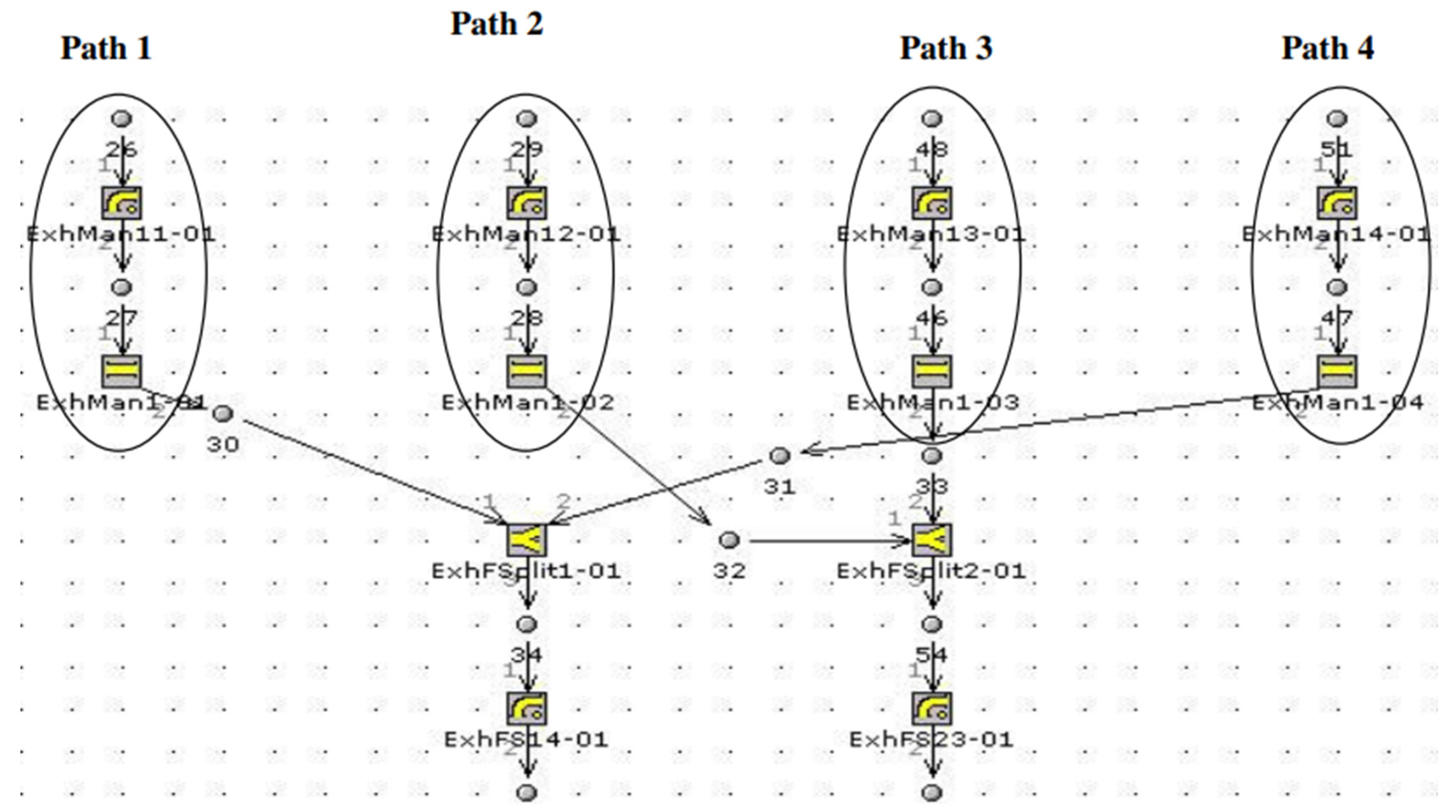

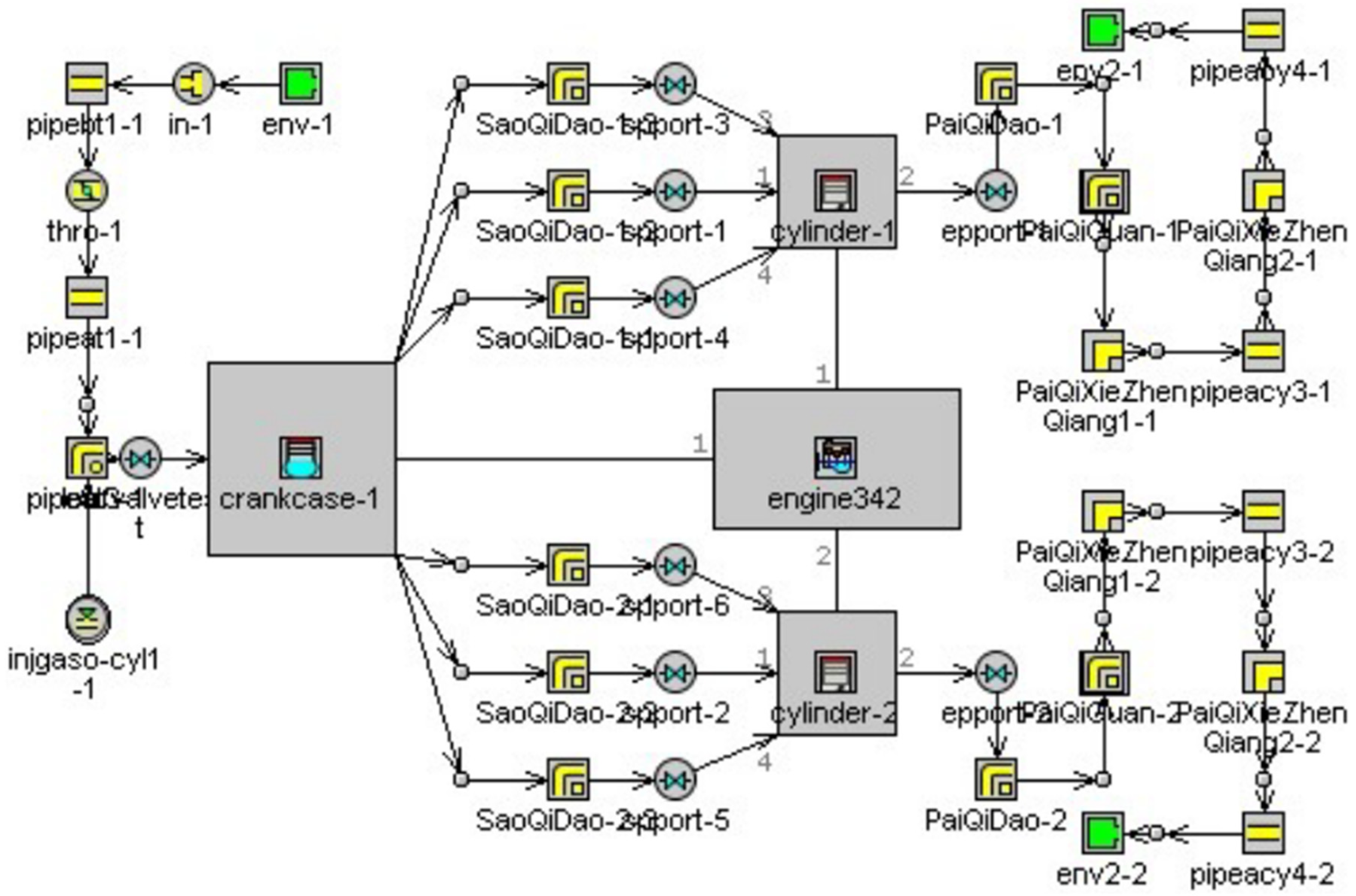




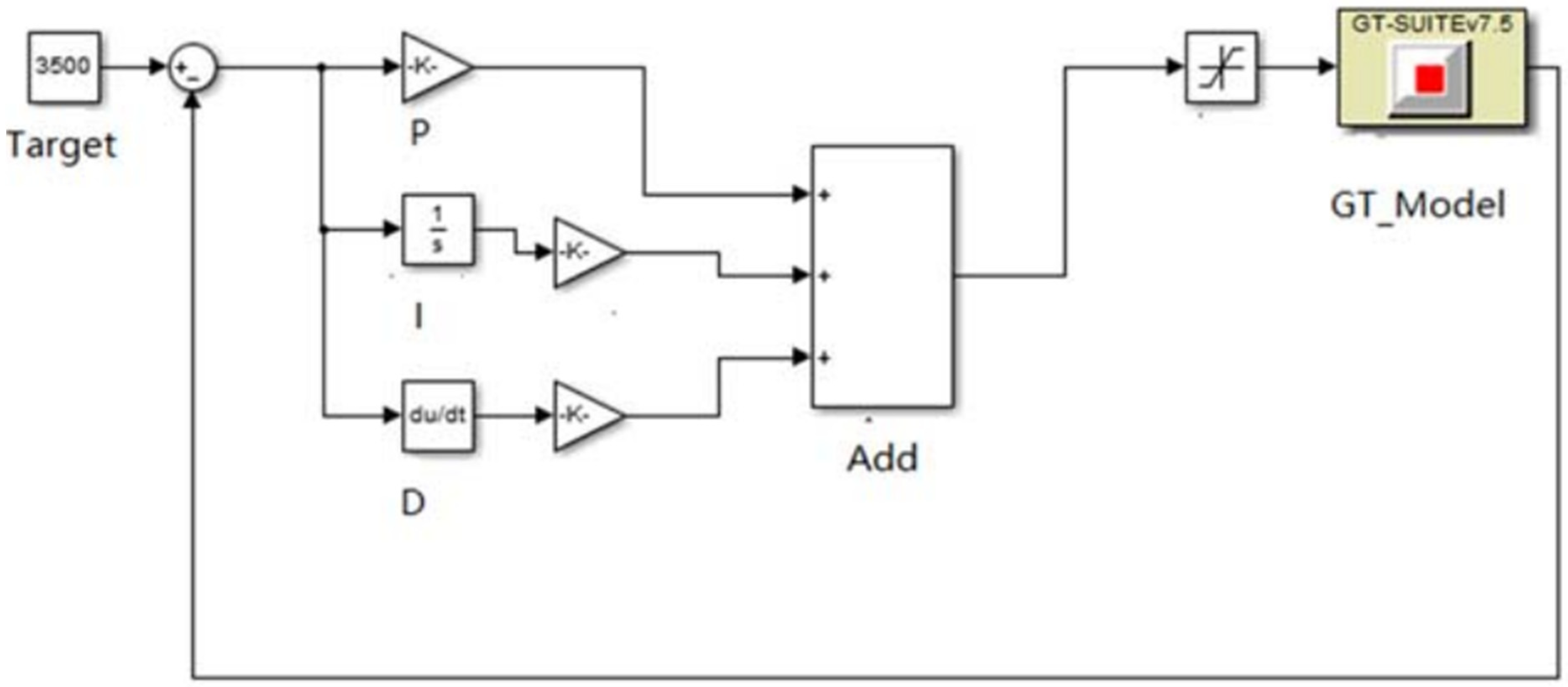


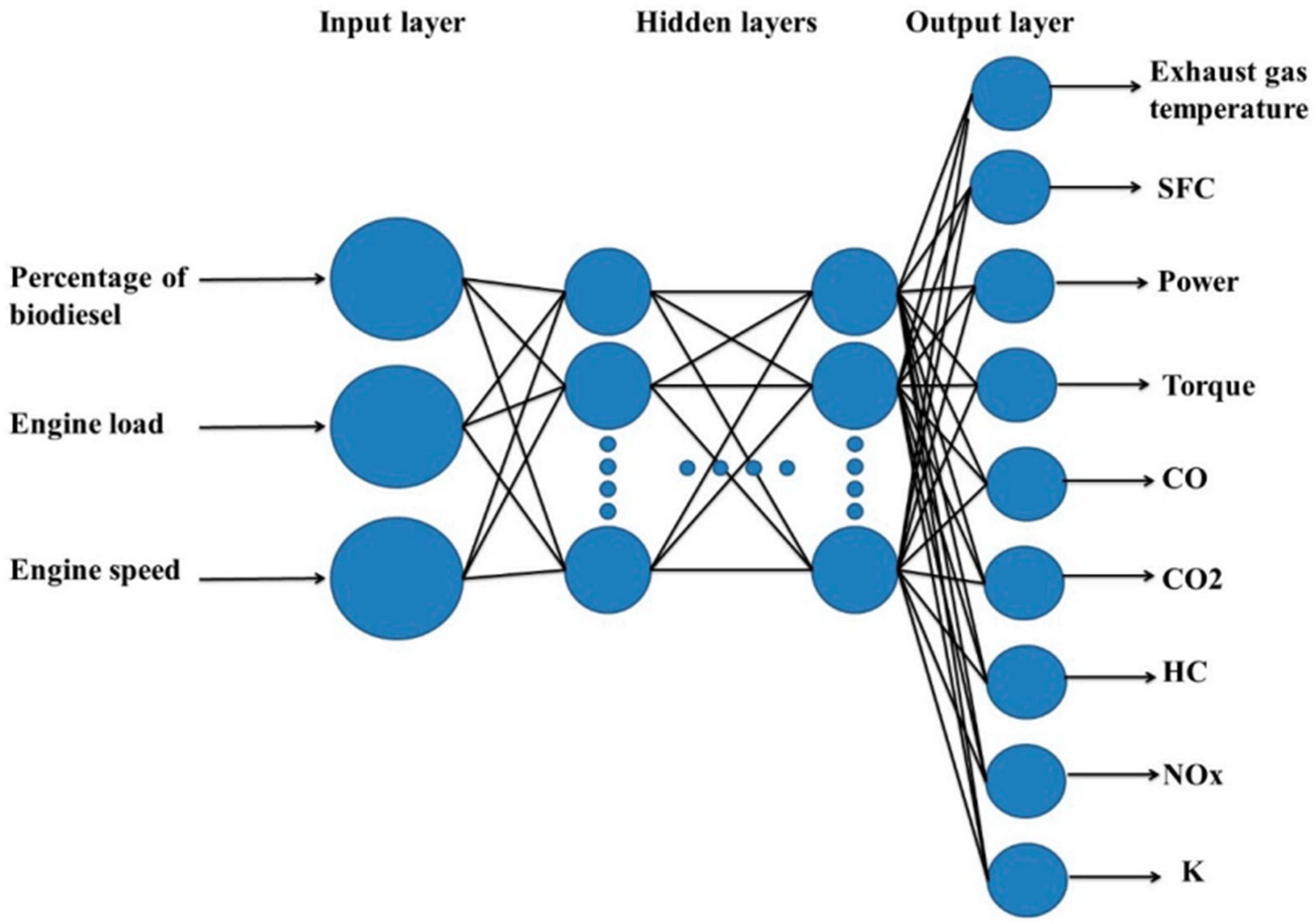


| Feature | Functionality |
|---|---|
| 1D modelling capabilities | 1D modelling techniques simplify complex engine system simulations, allowing for quick evaluation of different configurations and conditions. |
| Comprehensive component library | An extensive library of predefined engine components, including pistons, valves, turbochargers, and intercoolers, facilitates quick assembly of engine models. |
| Advanced combustion modelling | Supports various combustion models, such as multi-zone and single-zone approaches, enabling detailed simulation and analysis of combustion processes. |
| Thermodynamic analysis | In-depth thermodynamic analyses, calculating key parameters like pressure, temperature, and heat transfer throughout the engine cycle. |
| Fluid dynamics simulation | Effectively simulates fluid flow within engine components, offering insights into aerodynamics, fuel delivery, and scavenging processes. |
| Emission prediction | Includes tools for predicting emissions based on combustion characteristics, helping engineers optimize designs to meet regulatory standards. |
| User-friendly interface | The insightful graphical user interface (GUI) simplifies model creation and manipulation, allowing for easy visualization and adjusting the simulation. |
| Parameter sensitivity analysis | Provides capabilities for conducting sensitivity analyses, enabling users to identify critical parameters that significantly affect engine performance. |
| Data visualization tools | Offers powerful data visualization options, including graphs, charts, and animations, to help interpret simulation results effectively. |
| Integration with other software | Can interface with other simulation tools and software, such as MATLAB/Simulink, enhancing its versatility for multi-domain modelling approaches. |
| Real-time simulation | Supports real-time simulation capabilities, enabling on-the-fly adjustments and interactions during testing and development phases. |
| Custom model development | Flexibility to create custom components and systems, customizing the software to meet specific modelling needs or unique engine configurations. |
| Case studies and benchmarks | Provides access to various case studies and benchmarking data, enabling validation of the model against industry standards and historical performance parameters. |
| Feature/Aspect | GT-POWER | Converge CFD | ANSYS Fluent | AVL FIRE |
|---|---|---|---|---|
| Application | Designed for 1D engine modelling, allowing for analyses of engine performance, thermodynamics, and dynamic processes. | Optimized for detailed transient simulations of complex fluid flows, specifically tailored to IC engines. | A 3D CFD tool capable of handling detailed fluid dynamics and heat transfer simulations. | Focused on CFD simulations for IC engines and powertrains, excels in detailed combustion modelling. |
| Computational cost | Has lower computational costs due to its 1D modelling focus, which generally requires less computational power and time compared to 3D simulations. | Has high licensing costs and necessitates substantial computational resources due to its focus on detailed transient simulations. | High licensing costs that may disadvantage some potential users, and computational resource requirements can be significant for larger models. | Has high licensing fees. However, computational costs are moderate but can elevate due to demanding simulation requirements. |
| Model fidelity | Limited to 1D simulations; it focuses on thermodynamic processes but may lack the detail in fluid dynamics and multiphase interactions present in more advanced 3D tools. | Exceptionally high fidelity in turbulent flow and combustion modelling due to its adaptive meshing capabilities. | High modelling fidelity due to the capability of 3D modelling, especially with complex geometries and turbulent flows. | Excels in high-fidelity combustion modelling, providing detailed insights into thermal behavior and emissions. |
| Real-time capabilities | Its strong point lies in its rapid simulation capabilities for parametric studies and real-time performance evaluations, making it ideal for preliminary insights in the design phase. | Designed for real-time simulations, leveraging automatic meshing and efficient handling of complex flows to allow near-real-time evaluations. | Provides real-time simulation through live data streaming and integration with other ANSYS products, but complex scenarios may challenge real-time responsiveness. | Supports real-time analysis to some extent, particularly for engine performance during testing. |
| Limitations | Limited to 1D, lacks 3D capabilities. | High cost, resource-intensive for large models. | High licensing cost, complex setup. | Significant costs, limited beyond certain applications. |
| Description | Details |
|---|---|
| Create input files | Use Python to generate CSV or TXT files to specify engine parameters dynamically based on desired conditions. |
| Implement automation script | Write a Python script to call GT-POWER simulations using the generated input files (see Figure 17). |
| Run simulations | Execute the simulations in GT-POWER for the configured operating conditions. |
| Collect output data | Extract results such as pressure, temperature, torque, and emissions from GT-POWER. |
| Post-process results | Use Python to analyze and visualize output data (e.g., graphs and statistical summaries). |
| Validate results | Compare simulation outputs with experimental or previous similar findings data to verify model accuracy. |
| Repeat and refine | Adjust model parameters and rerun simulations as needed to improve fidelity. |
Disclaimer/Publisher’s Note: The statements, opinions and data contained in all publications are solely those of the individual author(s) and contributor(s) and not of MDPI and/or the editor(s). MDPI and/or the editor(s) disclaim responsibility for any injury to people or property resulting from any ideas, methods, instructions or products referred to in the content. |
© 2025 by the authors. Licensee MDPI, Basel, Switzerland. This article is an open access article distributed under the terms and conditions of the Creative Commons Attribution (CC BY) license (https://creativecommons.org/licenses/by/4.0/).
Share and Cite
Khanyi, N.; Inambao, F.L.; Stopforth, R. A Comprehensive Review of the GT-POWER for Modelling Diesel Engines. Energies 2025, 18, 1880. https://doi.org/10.3390/en18081880
Khanyi N, Inambao FL, Stopforth R. A Comprehensive Review of the GT-POWER for Modelling Diesel Engines. Energies. 2025; 18(8):1880. https://doi.org/10.3390/en18081880
Chicago/Turabian StyleKhanyi, Nhlanhla, Freddie Liswaniso Inambao, and Riaan Stopforth. 2025. "A Comprehensive Review of the GT-POWER for Modelling Diesel Engines" Energies 18, no. 8: 1880. https://doi.org/10.3390/en18081880
APA StyleKhanyi, N., Inambao, F. L., & Stopforth, R. (2025). A Comprehensive Review of the GT-POWER for Modelling Diesel Engines. Energies, 18(8), 1880. https://doi.org/10.3390/en18081880






